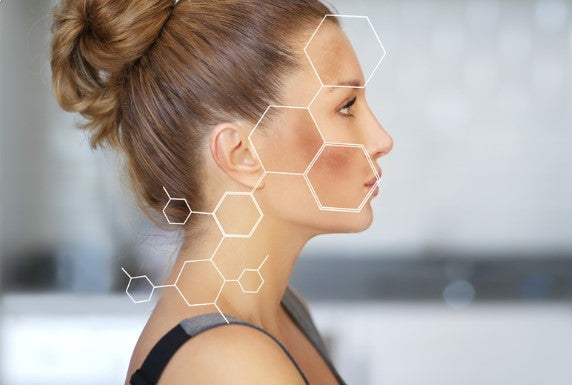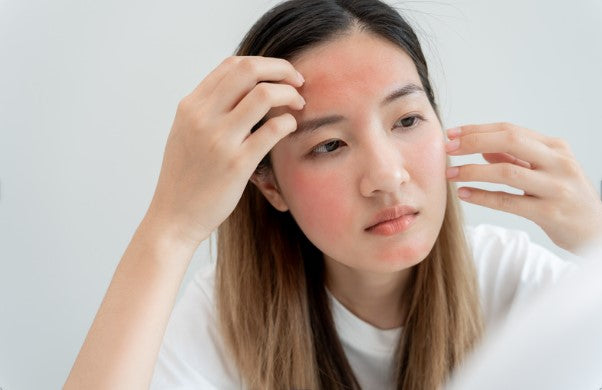
What is a sunspot?
Sunspots, also known as age spots, liver spots, and solar lentigines, are dark spots that can develop on areas of sun-exposed skin. These spots are usually benign and not a sign of cancer.
Quick links:
Sunspots are harmless, but some people choose to treat them for cosmetic reasons. Let’s learn what causes sunspots on the body and how you can treat them.
What causes sun spots?
Several factors can contribute to the development of sunspots on the skin:
- Excessive sun exposure and UV radiation. Prolonged exposure to ultraviolet (UV) rays from the sun is one of the primary causes of sunspots. UV radiation accelerates the production of melanin, the pigment that gives skin its color, leading to the formation of these pigmented spots.
- Aging. As we age, our skin's ability to repair itself and regulate melanin production decreases. This natural process can result in an accumulation of pigmented spots over time, especially in areas frequently exposed to the sun, such as the face, hands, and arms.
- Hormonal changes and imbalances. Fluctuations in hormones, particularly during pregnancy, menopause, or while taking certain medications like birth control pills, can trigger an increase in melanin production and the development of sunspots.
- Genetic predisposition. Some individuals are more genetically predisposed to developing sunspots due to their natural skin tone and melanin levels. Those with fair skin tend to be more susceptible to these pigmentation issues.
- Certain medications and medical conditions. Certain medications, such as anti-seizure drugs, can increase the skin's sensitivity to UV radiation, making it more prone to sunspots. Additionally, medical conditions such as Addison's disease or liver disease can contribute to their formation.
How to prevent sun spots?
Prevention is key when it comes to sunspots. With the adoption of sun-safe habits and the incorporation of the right skincare products into your routine, you can significantly reduce the risk of developing these unwanted pigmentation issues.
Here are some effective ways to prevent sunspots:
Use broad-spectrum sunscreen
Apply a broad-spectrum sunscreen with an SPF of 30 or higher to your face and other exposed areas to protect your skin from harmful UV rays. Reapply every two hours when spending time outdoors.
Wear protective clothing
The best sun protection is a combination of sunscreen and sun-protective clothing. SwimZip offers high-quality sun-protective clothing that will keep you sun-safe.
From surf suits and rash guards to wide-brimmed hats and UV-blocking sunglasses—we have everything you need to protect your skin from sunspots.
Seek shade
Try to limit your time in direct sunlight during peak hours (typically between 10 am and 4 pm), when the sun’s rays are the strongest.
If you want to go tanning, use our handy UV index tracker tool to plan around periods of high UV index..
Avoid tanning beds
Tanning beds emit harmful UV radiation that can accelerate the formation of sunspots and increase the risk of skin cancer. Even occasional tanning bed use can be detrimental to your skin's health and appearance.
Antioxidant-rich diet
A diet rich in antioxidants, such as vitamins C and E, can help protect your skin from UV damage and reduce the risk of hyperpigmentation. Berries, leafy greens, and citrus fruits are excellent sources of these beneficial antioxidants.
Manage hormonal changes
If hormonal fluctuations are contributing to sunspot formation, consult a dermatologist or healthcare provider about potential treatments or management options. They may recommend hormone therapy or other medications to help regulate your hormonal levels.
How to treat sun spots?
Here are some effective treatment options for reducing sunspots on the body:
At home treatments
These methods may take time and consistency to show results, but they can be a good starting point for mild sunspots.
- Aloe vera: contains compounds that can lighten sunspots.
- Apple cider vinegar: acetic acid in apple cider vinegar may help lighten skin pigmentation.
- Black tea: black tea water has been shown to have a skin-lightening effect.
- Green tea: green tea extract has a depigmenting effect.
- Licorice extract: known for lightening skin discoloration like sunspots.
- Milk: contains lactic acid that may help lighten sunspots.
- Vitamin C: topical application of vitamin C can protect against UV rays and lighten dark spots.
- Vitamin E: helps protect the skin against sun damage and may lighten sunspots.
- Over-the-counter creams: look for topical creams containing hydroxy acid, glycolic acid, kojic acid, or deoxyarbutin.
Professional treatments
These are typically more expensive but can offer faster and more dramatic results for stubborn sunspots. It is recommended to consult a dermatologist for these procedures.
- Facial peels: chemical peels can reduce sunspots by prompting the skin to peel off and regenerate.
- Laser treatment: specific lasers such as NewSurg or Fraxel Dual can target sunspots and improve overall skin complexion.
- Microdermabrasion: refines skin texture and reduces sunspots by removing the top layer of skin.
- Dermaplaning: gentle exfoliation method to remove damaged skin layers.
These treatments should be performed by trained professionals for optimal results and safety.
How to care for treated skin?
After undergoing skin treatments, you should prioritize sun protection to maintain the results and prevent further damage. The treated skin is often more sensitive and vulnerable to UV radiation, which can lead to hyperpigmentation and other complications.
Here's what you need to know:
Importance of sun protection after treatments
Sun exposure can undo the efforts of your sunspot treatment and cause the pigmentation to reappear or even worsen. Use a broad-spectrum sunscreen with an SPF of 30 or higher daily, and reapply it every two hours when outdoors.
Also, wear protective clothing, hats, and sunglasses to shield your treated skin from harmful UV rays.
Moisturize and nourish the skin
Many sunspot treatments can leave your skin feeling dry and irritated. Use a gentle, fragrance-free moisturizer consistently to soothe and hydrate your skin and promote a faster recovery process.
Look for moisturizers containing nourishing ingredients such as ceramides, hyaluronic acid, or antioxidants to support your skin's barrier function and overall health.
Avoid harsh products and irritants
After undergoing sunspot treatments, your skin may be more sensitive and vulnerable to irritation. Steer clear of harsh cleansers, scrubs, or products containing alcohol, retinoids, or alpha-hydroxy acids, as these can further irritate and damage your skin. Opt for gentle, fragrance-free skincare products designed for sensitive skin until your skin has fully recovered.
With proper care of your treated skin, you can maximize the benefits of your sunspot treatment and maintain a more even, radiant complexion. Be patient, as it may take several weeks or months to see the full results of your treatment.
Treatment durations
How long it takes to get rid of sunspots depends on what kind of treatment you choose. Most of the time, it can take a few weeks to a few months before you start to see your skin look better. For example, if you get dermabrasion, you might have to wait 6-8 weeks to see your skin get lighter.
Also, some treatments might need you to go back more than once. If you pick chemical peels, you can get them done again every 6-12 months if you need to keep your skin looking the way you want.
Sunspots on the sun vs. body sunspots
Sunspots on the sun are related to solar activity and the sun's magnetic field, while sunspots on the body are a skin condition caused by exposure to solar radiation.
Sunspots on the sun are dark spots that appear on the solar surface due to intense magnetic activity. These cool patches are caused by concentrations of magnetic field lines that inhibit the upward flow of hot gasses from the sun's interior. Sunspots are indicators of the solar cycle, an 11-year cycle of magnetic activity on the sun.
During solar maximums, sunspot activity increases, and the magnetic field becomes more complex, leading to more frequent solar events like coronal mass ejections and geomagnetic storms. Conversely, during a solar minimum, sunspot activity decreases, and the sun's magnetic field is less active.
Sunspots on the body are caused by prolonged exposure to solar radiation, particularly ultraviolet (UV) light. These dark spots appear on areas of the skin that receive the most sun exposure, such as the face, hands, and arms. While generally harmless, some sunspots may develop into cancerous spots if left untreated.
Sunspots on the body are not related to the sun's magnetic poles or the sunspots on the sun's surface.
Choose SwimZip
SwimZip's sun-protective beach apparel, made with UPF 50+ material, shields you from 98% of dangerous UVA and UVB rays and provides superior protection against sun damage.
Our sun-safe clothing is both practical and stylish. You will find different styles and sizes in our collections—there is a perfect pick for every family member.
Whether you plan a day at the beach or an outdoor excursion, SwimZip's gear keeps you safe from harmful sun exposure.
Check out some of our popular collections:
This aqua wide brim sun hat for kids will protect your children from harmful UV rays and keep them shaded while they play on the beach and in the water. Pair it with a rash guard made from UPF 50+ fabric for extra sun protection during long days outdoors.
Sunspot FAQ
Can sunspots turn cancerous?
Sunspots themselves are not cancerous, but they indicate excessive sun exposure, which can lead to skin cancer. Sunspots are benign pigmented spots that appear on sun-exposed areas of the skin. If a spot changes in size, shape, or color, it should be examined by a dermatologist to rule out skin cancer.
How rare are sunspots?
Sunspots are quite common, especially in people over 40 who have had significant sun exposure throughout their lives. They are more prevalent in fair-skinned individuals and those who live in sunny climates or spend a lot of time outdoors without proper sun protection.
Should I worry about dark sunspots on my skin?
Dark sunspots should be monitored for any changes in size, shape, or color. While most sunspots are harmless and benign, it's essential to differentiate them from potentially concerning skin conditions like melanoma. Consult a dermatologist if you notice any suspicious changes in your dark sunspots.
Is light skin more prone to sunspots?
Lighter skin tones are generally more prone to developing sunspots due to lower melanin levels providing less natural protection against UV radiation. People with fair skin may experience more pronounced pigmentation changes from sun exposure, which leads to an increased risk of developing sunspots.
Are sunspots signs of skin cancer?
Sunspots themselves are not signs of skin cancer; they are benign pigmented lesions caused by UV exposure. But, any new or changing spot (especially ones with irregular borders) on the skin should be evaluated by a dermatologist to rule out skin cancer. Regular skin checks and prompt medical attention for concerning spots are essential for early detection and treatment of skin cancer.
Further reading
How do I swim during my period?



Leave a comment
This site is protected by hCaptcha and the hCaptcha Privacy Policy and Terms of Service apply.